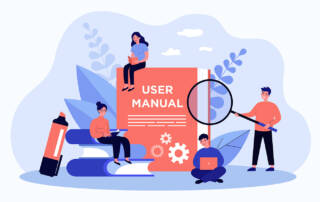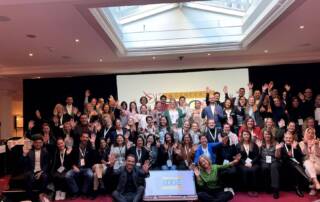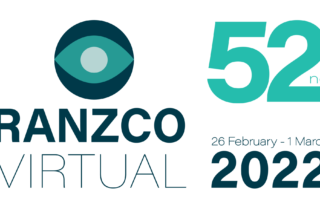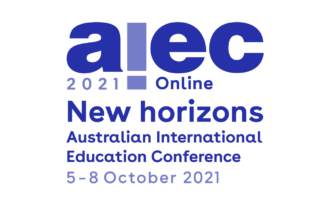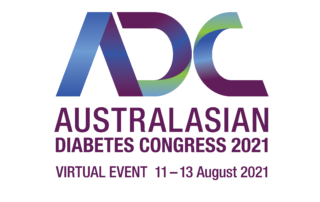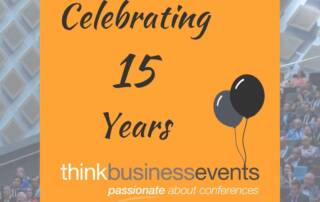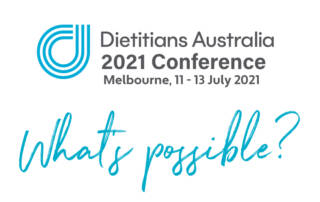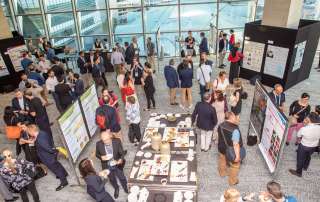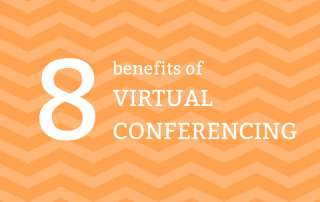What’s the difference between a webinar and a virtual conference?
More and more organisations are now offering online events such as webinars and virtual conferences. You have probably seen these terms (and more) but might not know the difference between the two.
At first glance the two share some similarities; both are delivered online, with presenter video and slide presentations, both allow attendees to ask questions, both can be recorded for future use, and can be either free or paid events. However, that’s where the similarities end and the confusion begins.
Fundamentally each online format is recreating a different type of face-to-face event in a digital environment.
A workshop or lecture can be turned into a webinar, with a single presenter delivering to a group. Usually held in a single short session up to 2 hours, webinars often have a focus on training and cover a single topic. Attendee interaction is often limited to polls and live Q&A with the presenter.
Whereas a virtual conference takes the essential elements of your annual conference and moves them into an interactive digital space facilitating many presenters and sessions over one or multiple days.
Sessions can happen in plenary or concurrently – where attendees choose from one of several online ‘rooms’. Additionally, virtual conference software can accommodate a wider variety of session types including world café small discussion groups and panel sessions.
Delegate to delegate interaction is higher in a virtual conference with features such as delegate profiles, discussion forums and direct messaging. Opportunities to engage delegates can be expanded using social media, and conference hosts can leverage the longer run time of the event to develop online conversations and build community.
Sponsorship opportunities are another point of difference, with virtual conference software allowing specialised features and increased visual branding opportunities for sponsors and exhibitors. Sponsors can create dedicated profile pages and include videos, documents and resources, contact information, discussion forums and communicate with attendees via direct messaging.
These elements work together to recreate the immersive and engaging environment attendees, speakers and sponsors enjoy at your regular face to face conference and create a true industry networking experience.
Webinars and virtual conferences are distinct online event formats that each have pros and cons depending on the kind of content and experience you are looking to deliver to attendees. Now that you know the difference you can choose the format that best suits you audience and objectives.
Looking to run a virtual conference or other online event? Think Business Events can help take you from planning through to execution and evaluation. Contact us for more information.
Looking to run a virtual conference or other online event? Think Business Events can help take you from planning through to execution and evaluation.
Read More of Our Event Thoughts
- Think Business Events Partners with Hidden Disabilities Sunflower to Enhance Accessibility at EventsKim Stevenson2024-11-25T15:30:49+11:00
Think Business Events Partners with Hidden Disabilities Sunflower to Enhance Accessibility at Events
- How To Prepare When Attending Your First ConferenceKim Stevenson2023-03-20T16:07:18+11:00
How To Prepare When Attending Your First Conference
- Kim’s trip to Geneva and the IAPCO EDGE SeminarKim Stevenson2023-01-27T15:19:43+11:00
Kim’s trip to Geneva and the IAPCO EDGE Seminar
- We asked some of our team ‘What’s in your conference kit?’Kim Stevenson2022-11-21T14:46:55+11:00
We asked some of our team ‘What’s in your conference kit?’
- 6 important things to remember when organising an international conferenceKim Stevenson2022-09-30T16:51:56+10:00
6 important things to remember when organising an international conference
- Case Study: The Australian Defence Science, Technology & Research SummitKim Stevenson2022-10-10T10:47:15+11:00
Case Study: The Australian Defence Science, Technology & Research Summit
- Case Study: The Australasian College of DermatologistsKim Stevenson2022-06-09T11:55:32+10:00
Case Study: The Australasian College of Dermatologists
- Case Study: Royal Australian and New Zealand College of OphthalmologistsKim Stevenson2022-04-07T17:11:31+10:00
Case Study: Royal Australian and New Zealand College of Ophthalmologists
- Case Study: Australian International Education Conference 2021Kim Stevenson2022-02-03T13:17:15+11:00
Case Study: Australian International Education Conference 2021
- 18 months of virtual and hybrid conferencing – these are our top 5 takeawaysKim Stevenson2022-09-27T12:46:37+10:00
18 months of virtual and hybrid conferencing – these are our top 5 takeaways
- Returning to face-to-face events 2.0admin2022-09-27T12:45:07+10:00
Returning to face-to-face events 2.0
- Case Study: Australasian Diabetes Congress 2021Kim Stevenson2022-09-27T12:44:30+10:00
Case Study: Australasian Diabetes Congress 2021
- Celebrating 15 years of Think Business Eventsadmin2021-09-22T14:50:01+10:00
Celebrating 15 years of Think Business Events
- Case Study: Dietitians Australia 2021Kim Stevenson2022-09-27T12:43:44+10:00
Case Study: Dietitians Australia 2021
- Exploring the new world of hybrid eventsKim Stevenson2022-09-27T12:42:53+10:00
Exploring the new world of hybrid events
- Returning to face-to-face eventsKim Stevenson2020-09-02T11:55:48+10:00
Returning to face-to-face events
- Our favourite virtual sponsorship opportunitiesadmin2022-09-27T12:35:50+10:00
Our favourite virtual sponsorship opportunities
- What’s the difference between a webinar and a virtual conference?admin2022-09-27T12:33:27+10:00
What’s the difference between a webinar and a virtual conference?
- Five Stages of the Conference Marketing Cycleadmin2022-09-27T12:27:59+10:00
Five Stages of the Conference Marketing Cycle
- Working from home: Staying productive and connectedadmin2020-04-06T17:26:27+10:00
Working from home: Staying productive and connected



